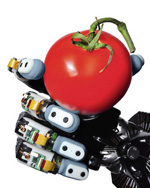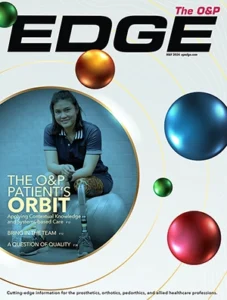Researchers at the University of Southern California (USC), Los Angeles, Viterbi School of Engineering, published a study June 18 in Frontiers in Neurorobotics showing that a specially designed robot can outperform humans in identifying a wide range of natural materials according to their textures, paving the way for advancements in prostheses, personal assistive robots, and consumer-product testing.

The BioTac robotic finger sensors, installed here on the Barrett Technology BarrettHand, could be used in human prostheses or to assist companies who employ experts to judge the feel of consumer products and even human skin. Photograph courtesy of SynTouch.
The robot was equipped with a new type of tactile sensor, the SynTouch BioTac® sensor, built to mimic the human fingertip. It also used a newly designed algorithm to make decisions about how to explore the outside world by imitating human strategies. The sensor is capable of other human sensations, which allows it to identify where and in which direction forces are applied to the fingertip and the thermal properties of an object being touched.
Like the human finger, the group’s BioTac sensor has a soft, flexible skin over a liquid filling. The skin even has fingerprints on its surface, enhancing its sensitivity to vibration. As the finger slides over a textured surface, the skin vibrates in characteristic ways. These vibrations are detected by a hydrophone inside the bone-like core of the finger. The human finger uses similar vibrations to identify textures, but the BioTac is even more sensitive, the researchers claim.
When humans try to identify an object by touch, they use a wide range of exploratory movements based on their prior experience with similar objects. A famous theorem by 18th century mathematician Thomas Bayes describes how decisions might be made from the information obtained during these movements. Until now, however, there was no way to decide which exploratory movement to make next. The study, authored by professor of biomedical engineering Gerald Loeb, MD, and Jeremy Fishel, PhD, who recently completed his doctoral dissertation in biomedical engineering based on the texture research, describes their new theorem for this general problem as “Bayesian Exploration.”
Built by Fishel, the specialized robot was trained on 117 common materials gathered from fabric, stationery, and hardware stores. When confronted with one material at random, the robot could correctly identify the material 95 percent of the time, after “intelligently” selecting and making an average of five exploratory movements. It was only rarely confused by a pair of similar textures that human subjects could not distinguish at all by making their own exploratory movements.
Another paper from this research group in the same issue of Frontiers in Neurorobotics describes the use of their BioTac sensor to identify the hardness of materials like rubber.
Original funding for development of the sensor was provided by the Keck Futures Initiative of the National Academy of Sciences to develop a better prosthetic hand for amputees. SynTouch also received a grant from the National Institutes of Health to integrate BioTac sensors with such prostheses. The texture discrimination project was funded by the U.S. Defense Advanced Research Projects Agency (DARPA) and the material hardness study by the National Science Foundation.
Editor’s note: This story has been adapted from materials provided by the USC Viterbi School of Engineering.




